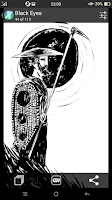Julio's Day by Gilbert Hernandez (2013)
, 7 Feb 2016
Julio's Day is actually a book about Julio's (family) Life. A charming BW time travel from the coming out of nothingness of Julio Reyes in 1900 to his passing into nothingness in the year 2000. Although set in America's South, most of the characters are Mexican or from Mexican origin and culture. This is a charming trip for the reader, with so many things happening in the life of Julio's family. There is love and hatred, dark secrets, innocence, innocence lost, gay repressed sex and explicit sex, treason, murder, madness, hilarious bizarre moments, joy and sadness. The only chronological anchors are the references to the wars that spanned the 20th century, changes in clothing and some social references that are easily associated with specific decades. There is also a visual anchoring in the depiction of the town's progressive industrialisation.
I know that the author and the book have been defined as within the Magic Realism genre. To me, there is little or nothing of Magic Realism in this book. I think MR is used too often to describe works that have some oddity about them and people cannot categorise. In this book there are episodes of mental alienation, trippy, but that is it. To me, this book connects more with Latin-American family-saga telenovelas than with anything else. Hernández does a great job at infusing this family saga with enough charm, realism, and lack of 'Manichaeism' to get the story away of extreme non-believable characters. The story feels organic, alive, as it was real. The characters feel also real. In fact, I have known people who were like those in this book. On the other hand the characters are just schetched because there are many and the period covered isis very long.
One of the main elements of Mexican culture (and Hispanic/Spanish) culture is how death is understood, perceived and faced. This is especially valid for Mexicans in the period Hernández describes. However, it connects with stories and attitudes that were common in rural areas during my childhood even though I am not Mexican. There is a familiarity with death, a presence of death and of the dead in life, because death is part of life, not in a creepy morbid horror way, you show r-e-s-p-e-c-t- to death because it is another passage rite. That awareness of death also keeps people more grounded in life and there is less fear, less avoidance. This is perfectly captured in this book. I love the presence of the hill with the tombstone crosses, and how some of the death of the characters is depicted.
This is a male dominated story with strong female characters performing traditional roles. This is how it was in rural areas in many parts of the world decades ago, and I think Hernández captures this with veracity. In this case, Renata summarises well the role that some women played, and the sort of life that those women had in that historical context. Just one example. Renata is strong and caring, but she often says "women need of no reasons", which sounds a bit like women are irrational. In that context, though, women used to say this sort of thing because they had proof of their reasons, or inner knowing, or they just knew, but didn't want to speak about it. Araceli's character is perhaps the most interesting in the whole book. I would have loved that Hernández developed a bit more her character; she appears as a nun-ish good samaritan, but there much more juice about her that was not explored.
I found the male characters interesting and varied enough to make the story entertaining. Julio's character seems, in comparison, a secondary one not the main one. He is always there, a sweet gentle man, mostly in the background. This has a narrative purpose, of course. There are very few scenes in which we seem him happy, and they always revolve around a person. We see him feeling, alive, in just one scene close to the end of the book. I cried at the end, out of sadness for the character, and because I know men like him in real life: people who live life without the courage of being true to who they are, lead a pleasant empty life that does not satisfy them inside, aim to the unattainable probably because it is a fantasy that doesn't require of them doing something to create their life experience. Living is not just existing. In that regard, Julio's Dayim shows just that. Julio has an existence of 100 years but he really lived for one day. A microperiod of real life between two big empty holes of nothingness separated by 100 years. I liked the quote by Samuel Becket that Evenson's chose for his brief introduction: "one day we were born, one day we shall die, the same day, the same second, is that not enough for you?". Life is like a fleeting moment is another way of putting it.
I have a mix of feelings about Hernández's visual style. I love his shadow silhouetted landscapes, and his long distance scenes, theyare superb: beautifully composed, lyric, and with enough pathos to be another character in the story. I love some of the facial expressions in children, and some shocking scenes with the WW1-veteran neighbour. Although I enjoyed the vignettes, I found some of the pages and vignettes too crowded and the depiction of some characters too "chunky".
This is not a book for children.


























































